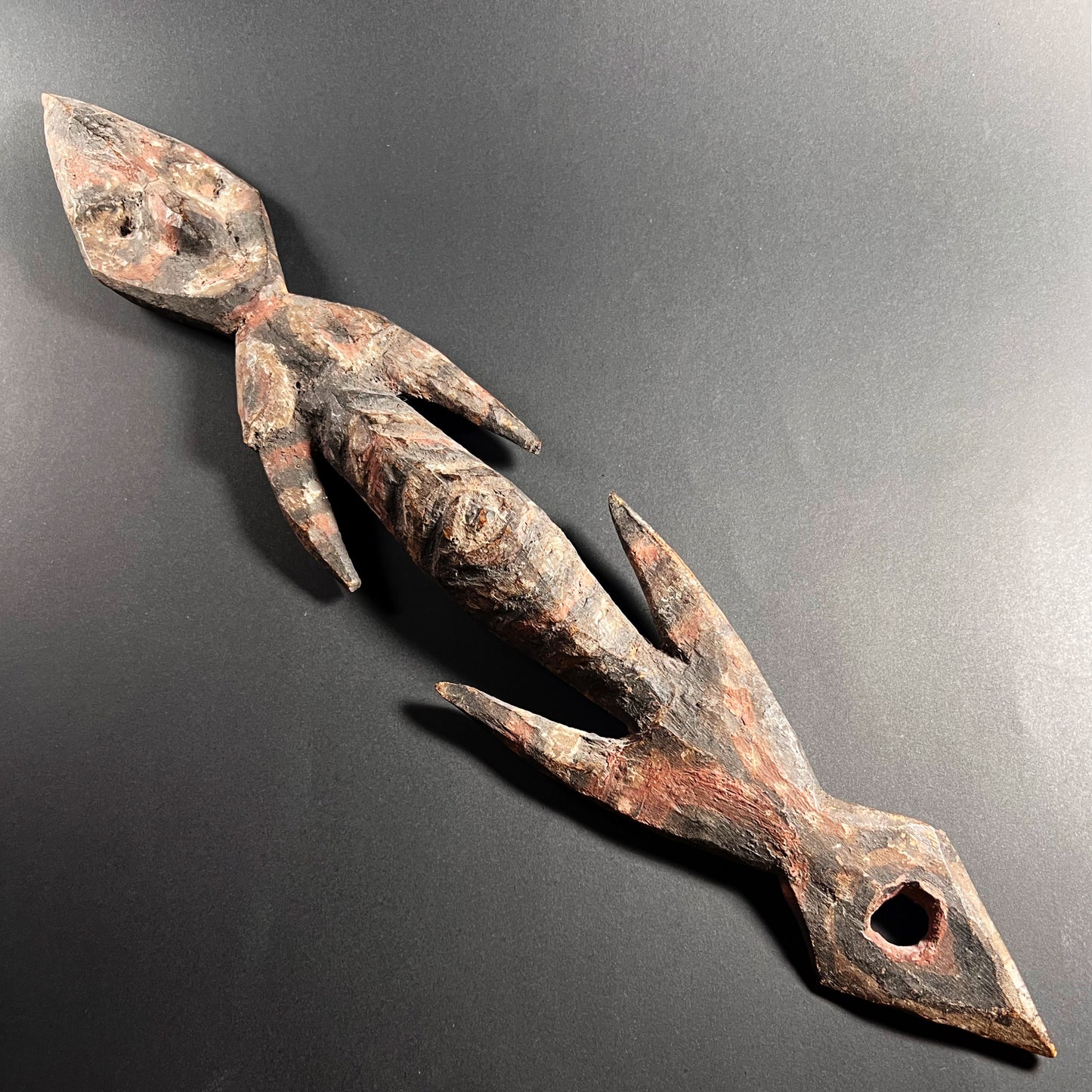Iatmul Suspension Hook Figure
Iatmul Suspension Hook Figure
Couldn't load pickup availability
Iatmul People, Mid 20th Century, East Sepik Province, Papua New Guinea
A finely carved and painted wooden suspension hook featuring two anthropomorphic figures, one with a triangular face, beaked nose, and simply rendered eyes. Another figure occupies the rear end of the object, its arms extending outward to form the functional hooks. The opposite end echoes the same overall form but is carved without facial features, bearing only a single drilled aperture where the face would conventionally appear; its arms likewise form hooks midway along the body. Both ends are decorated in traditional pigments, displaying the bold linear and curvilinear motifs characteristic of Iatmul carving.
Suspension hooks of this type blend utility with deep spiritual significance. In daily use, they were hung from the rafters of men’s houses to safeguard food, clothing, and treasured belongings, which were placed in baskets or string bags suspended from the prongs to protect them from vermin. In their ceremonial role, however, they could serve as potent embodiments of ancestral spirits or clan totems. Some hooks depicted waken—the most powerful Iatmul supernatural beings—whose presence could be consulted by men before raids or hunting expeditions. Through these carved forms, the ancestors were believed to manifest their guidance and power.
The Iatmul inhabit the middle course of the Sepik River and number roughly eight to ten thousand people, grouped into eastern (woliagui), central (palimbei), and western (nyaura) subgroups. Their social structure, kinship organisation, and ritual systems are notably complex. Prior to sustained Western contact, head-hunting expeditions were a central feature of inter-village warfare. Traditional Iatmul belief is anchored in the spirits of the rivers, forests, and swamps. Ancestor spirits—wagen—are considered powerful and potentially dangerous, necessitating ritual appeasement. Other classes of beings include malevolent spirits (marsalai) and water- or bush-dwelling entities such as wansimot/wanjimout and winsumbu/winjumbu. Each clan typically venerates a particular species of animal or plant as a totemic ancestor (ngwail).
Iatmul art is renowned for its superb carving and vibrant painted ornament. Almost all objects—from masks and figures to architectural elements and overmodelled skulls—derived meaning through their ritual use. Human faces, often stylised with long beaked noses and varied configurations of eyes and mouth, appear with great frequency. Figures are commonly integrated with birds, animals, shells, feathers, and other embellishments, resulting in artworks of extraordinary visual dynamism and symbolic depth.
Good condition. Surface wear and abrasions commensurate with age and use. Deep dark brown patina. Faded colours. Size approx. 47,0cm x 8,0cm x 2,5cm
Provenance: Dutch private collection
References and further reading:
Iatmul Art as Iconography (New Guinea), Ina R. Dinerman, Anthropos Bd. 76, H. 5./6, 1981, Published by Nomos Verlagsgesellschaft mbH, pp. 807-824.
Surviving Traditional Art of Melanesia, John E. Edgerly, The Journal of the Polynesian Society, Vol. 91, No. 4, December 1982, Published by The Polynesian Society, pp. 543-579.
The mother and her ancestral face. A commentary on Iatmul iconography, Christian Kaufmann, Dossier Hommage à Bernard Juillerat, p. 173-190. (https://doi.org/10.4000/jso.6182.)
The Pairing of Musicians and Instruments in Iatmul Society, Gordon D. Spearritt, Yearbook for Traditional Music, Vol. 14, 1982, Published by Cambridge University Press, pp. 106-125.




-
Shipping
The shipment will be prepared in the course of 3-5 days and dispatched via Posti Group Oyj or purchased item(s) can be picked up from our shop during the store's opening hours (Tarkk’ampujankatu 4, 00140, Helsinki, Finland). Within the Finland, all items are shipped via Posti Group Oyj unless otherwise requested. We pack the items carefully and mainly in recycled materials because we want to save nature. You will receive the tracking number for your items by e-mail.
-
Returns
Returns and exchange will be accepted within fourteen days (14) of receipt at the purchaser’s cost to include freight and packaging. Items must be returned in the same condition as when they were shipped, and will not be accepted if damaged or altered in any way. Please inform us via email (info@gotanmaailma.fi) or by calling +358408408352 before sending. We do not accept returns more than 14 days after delivery.




